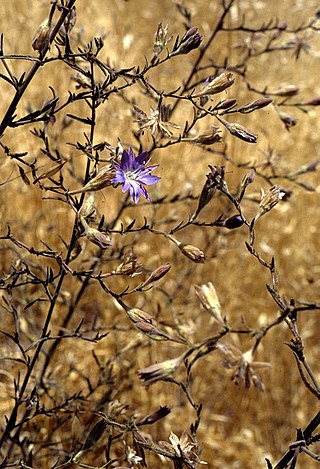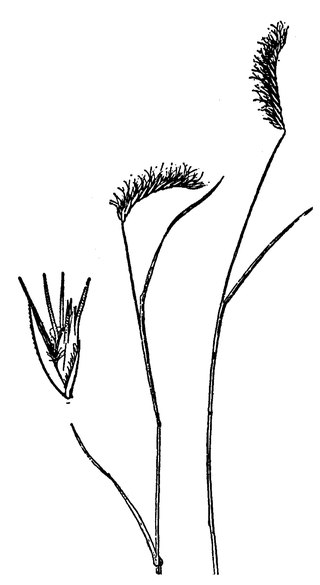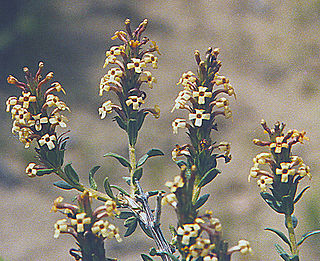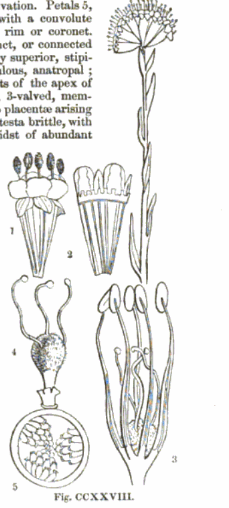
South America is a continent entirely in the Western Hemisphere and mostly in the Southern Hemisphere, with a relatively small portion in the Northern Hemisphere at the northern tip of the continent. It can also be described as the southern subregion of a single continent called America.

Alstroemeriaceae is a family of flowering plants, with 254 known species in four genera, almost entirely native to the Americas, from Central America to southern South America. One species of Luzuriaga occurs in New Zealand, and the genus Drymophila is endemic to south-eastern Australia.

Arica is a commune and a port city with a population of 222,619 in the Arica Province of northern Chile's Arica y Parinacota Region. It is Chile's northernmost city, being located only 18 km (11 mi) south of the border with Peru. The city is the capital of both the Arica Province and the Arica and Parinacota Region. Arica is located at the bend of South America's western coast known as the Arica Bend or Arica Elbow. At the location of the city are two valleys that dissect the Atacama Desert converge: Azapa and Lluta. These valleys provide citrus and olives for export.

Malesherbia is a genus of flowering plants consisting of 25 species in the Passifloraceae. This is a xerophytic group endemic to the Peruvian and Chilean deserts and adjacent Argentina. The genus is currently recognized by the APG III system of classification in the family Passifloraceae, and is the sole member of the subfamily Malesherbioideae.

Hipólito Ruiz López, or Hipólito Ruiz, was a Spanish botanist known for researching the floras of Peru and Chile during an expedition under Carlos III from 1777 to 1788. During the reign of Carlos III, three major botanical expeditions were sent to the New World; Ruiz and José Antonio Pavón Jiménez were the botanists for the first of these expeditions, to Peru and Chile.

Jungia is a genus of flowering plants in the family Asteraceae. It is native mostly to South America, with one widespread species extending its range into Central America and southern Mexico.

Hoffmannseggia is a genus of flowering plants in the pea family, Fabaceae, known generally as rushpeas. These are pod-bearing herbs and subshrubs native to the Americas. In North America they range from California and Nebraska to southern Mexico, and from Colombia, Ecuador, and Peru to southern Argentina and Chile in South America. The generic name honors Johann Centurius, Count of Hoffmannsegg, a nineteenth-century German nobleman and botanist.

Proustia is a genus of flowering plants in the family Asteraceae, native to South America and the West Indies.

Balbisia is a genus of flowering plants belonging to the family Francoaceae. It is also in the Vivianiaceae subfamily.

Trichloris is a genus of New World plants in the grass family.

Bouteloua simplex, colloquially known as matted grama or mat grama, is a grass species in the grama genus native to much of the Americas.

Mulguraea is a genus of flowering plants belonging to the family Verbenaceae.

Malesherbia angustisecta is an endangered member of Malesherbia (Passifloraceae). It is colloquially called clavelina. The first published description of the species dates to 1922 and Hermann Harms is accredited with its discovery. It is native to arid and semiarid deserts of Peru. It is a pale green woody shrub and has pale pink / white flowers.

Malesherbia arequipensis is a herbaceous member of Malesherbia (Passifloraceae) with white flowers. It first described in 1961 by botanist Mario H. Ricardi Salinas and is native to Arequipa and Moquegua. It is the only member of Malesherbia that grows outside of the Andes. It grows up to 15 cm tall and has white flowers.

Malesherbia auristipulata is a perennial woody shrub in the genus Malesherbia (Passifloraceae). Locally it is called Ají de Zorra. M. auristipulata is commonly found in Northern Chili and rarely in Tacna, Peru. In general, the species range is very restricted as a result M. auristipulata is considered a rare plant. It is likely that there are less than 100 individuals left, classifying the species as critically endangered by the local government.

Malesherbia fasciculata is a subshrub that is native to the subtropics of Northern and Central Chile. The flowers of M. fasciculata are white with red sepals, dark purple anthers, and are globular in shape.

Malesherbia humilis is an annual herb that grows in the subtropics of northern and central Chile to Argentina.
Malesherbia solanoides is a subshrub native to the Atacama region of Chile. It was initially described in 1833 by Reise Erde.
Malesherbia splendens is a subshrub native to the Lurín river basin of the Andean region of Peru. It is found at altitudes of 2100-3000m. It can grow up to 1 meter tall and has yellow/green flowers. It has low genetic diversity, potentially due to its small species range. It is currently classified as endangered due to low genetic diversity and diminishing species boundary due to the expansion of goat farming.
Malesherbia tocopillana is a subshrub native to Tocopilla, Antofagasta Chile. It is found in costal deserts at altitudes of 150 - 400 m. It reaches heights of 50 cm, has 25 - 65mm long leaves and simple racemes pink flowers. It is considered a very rare plant, with only 9 live individuals documented, as such, it is classified as endangered.
















